Surface Disinfection Market Outlook - 2032
The global surface disinfection market size was valued at $2.7 billion in 2022, and is projected to reach $5.6 billion by 2032, growing at a CAGR of 7.4% from 2023 to 2032. The surface disinfection market is driven by an increase in hospital-acquired diseases and surge in utilization of surface disinfectants across diverse sectors such as manufacturing, hospitality, and food and beverage.
A surface disinfectant is a chemical substance or product designed to kill or eliminate pathogens (such as bacteria, viruses, and fungi) on surfaces. These disinfectants are used in various settings, including homes, healthcare facilities, public spaces, and industrial environments, to reduce the risk of infections and maintain a clean and hygienic environment. Surface disinfectants come in various forms, such as liquids, sprays, wipes, and powders. They typically contain active ingredients that have antimicrobial properties, which target and destroy or inhibit the growth of microorganisms on surfaces.
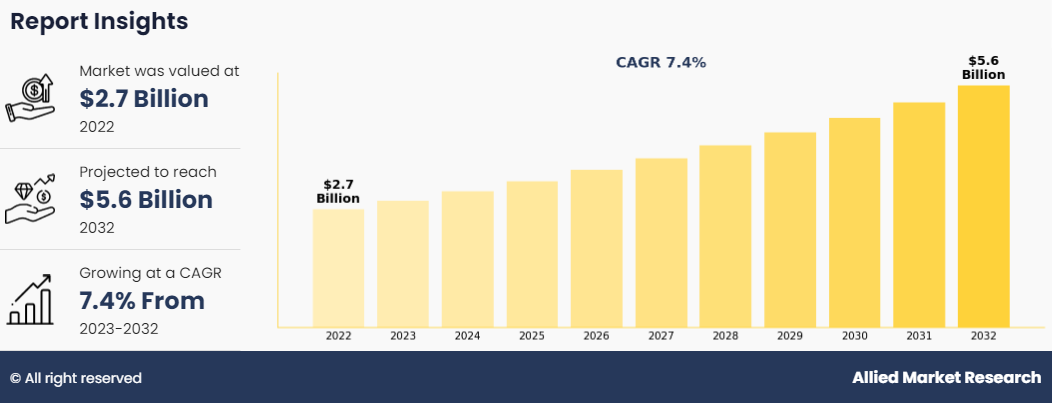
Key Takeaways:
- Quantitative information mentioned in the global surface disinfection market analysis includes the market numbers in terms of value ($Million) concerning different segments, pricing analysis, CAGR (2023-32), and growth analysis.
- The analysis in the report is provided on the basis of composition, type, application, and region. The study is expected to contain qualitative information such as the market dynamics (drivers, restraints, opportunities), Porter’s Five Force Analysis, key regulations across the region, and value chain analysis.
- A few companies, including 3M, BASF SE, Ecolab, LANXESS, Lonza, P&G, and PAUL HARTMANN AG hold a large proportion of the surface disinfection market.
- This report makes it easier for existing market players and new entrants to the Surface Disinfection industry to plan their strategies and understand the dynamics of the industry, which helps them make better decisions.
Market Dynamics
Rise in the occurrence of hospital-acquired infections (HAIs) drives the surface disinfection market growth. Hospitals, being critical healthcare settings, are susceptible to the spread of infections due to the constant entry of patients and the presence of various pathogens. According to a recent report by the World Health Organization (WHO), out of every 100 patients in acute-care hospitals, seven patients in high-income countries and 15 patients in low- and middle-income countries acquire at least one health care-associated infection (HAI) during their hospital stay. On average, 1 in every 10 affected patients die from HAI. Moreover, there is a greater need for efficient surface disinfectants primarily from healthcare facilities that adopt stringent precautions to prevent infections in response to the rise in HAI incidence.
Healthcare providers actively seek reliable and potent surface disinfectants to minimize the risk of infections within their facilities. The surface disinfection market forecast has experienced a significant surge due to the adoption of stringent cleaning and disinfection practices by hospitals and other healthcare institutions. It is essential to keep the surroundings clean to avoid infections among patients, medical staff, and visitors. The significance of using excellent surface sanitizers has been highlighted by many regulatory bodies and health associations. For example, the World Health Organization suggests using 70% alcohol-based solutions or sodium hypochlorite at a concentration of either 0.1% or 1,000 ppm for surface disinfection. Thus, an increase in prevalence of hospital-acquired infections is expected to boost the surface disinfection market size growth during the forecast period.
The wide utilization of surface disinfectants in non-healthcare sectors drives the market growth. Industries such as hospitality, food and beverage, education, and manufacturing recognize the importance of ceaning surfaces to ensure the safety of their employees and customers. In the hospitality sector, hotels, restaurants, and entertainment venues prioritize cleanliness to enhance customer satisfaction and prevent the spread of infections. Similarly, educational institutions incorporate rigorous hygiene practices to safeguard students and staff. The food and beverage industry adheres to stringent sanitation standards to meet regulatory requirements and ensure the safety of the food supply chain.
Furthermore, the manufacturing sector has implemented surface disinfection protocols to maintain sterile production environments and protect the integrity of products. Thus, usage of surface disinfectants in the non-healthcare sector is expected to boost market growth during the forecast period. The surface disinfection market growth is hindered due to product resistance and overuse of surface disinfectants. The active chemicals of disinfectants cause infections to become resistant to them over time, decreasing their ability to eradicate harmful microbes. This phenomenon raises concerns in healthcare settings as contributes to the establishment of resistant strains of viruses and bacteria due to repeated use of disinfectants.
The overuse of surface disinfectants creates a selective pressure, promoting the survival and proliferation of microbes that exhibit resistance to commonly used antimicrobial agents. This poses a significant hurdle in maintaining the desired level of hygiene, as the products designed to eliminate pathogens become less potent over time. Moreover, the excessive and indiscriminate use of surface disinfectants have adverse effects on both human health and the environment. Prolonged exposure to certain disinfectant chemicals leads to health issues such as respiratory problems and skin irritation. In addition, the production and disposal of disinfectant products contributes to environmental concerns, including the release of potentially harmful chemicals. Thus, product resistance and overuse of surface disinfectants restrain surface disinfection market share.
The significant advancements in surface disinfectants offer an excellent growth opportunity for the expansion of the market. The development of next-generation formulations with advanced antimicrobial agents expands the capabilities of surface disinfectants, which allows them to effectively combat a broader spectrum of pathogens, including bacteria, viruses, and fungi. This increased efficacy is a key factor that drives the adoption of these advanced disinfectants, particularly in healthcare settings where stringent infection control measures are important. The surface disinfection market trends show that the integration of nanotechnology into disinfectant formulations has enhanced their effectiveness. Nanoparticles significantly improve the antibacterial properties of these products, which prevent the spread of disease. This increased efficacy is applicable to other areas where cleanliness is essential, such as the manufacturing, education, hospitality, and healthcare sectors. Thus, advances in the formulation of surface disinfectants present lucrative growth opportunity for the expansion of surface disinfection market.
Segments Overview
The surface disinfection market is segmented on the basis of composition, type, application, and region. On the basis of composition, the market is classified into alcohols, chlorine compounds, quaternary ammonium compounds, hydrogen peroxide, peracetic acid, and others. On the basis of type, the market is segregated into liquids, wipes, and sprays. Depending on the application, the market is divided into surface, instrument, and others. Region-wise, the market is studied across North America, Europe, Asia-Pacific, and LAMEA.
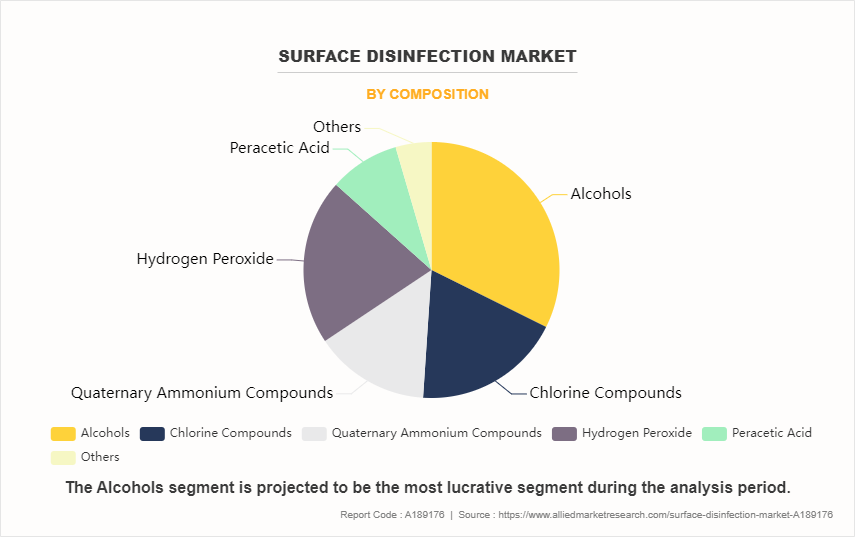
Surface Disinfection Market By Composition
The alcohols segment accounted for the largest share in 2022 and is expected to register the highest CAGR of 8.0%. This can be attributed to its broad-spectrum antimicrobial properties and quick evaporation, leaving no residue. The surge in demand for alcohol-based surface disinfectants is propelled by the need for efficient and rapid disinfection solutions, particularly in healthcare, hospitality, and household settings, thereby fueling market growth.
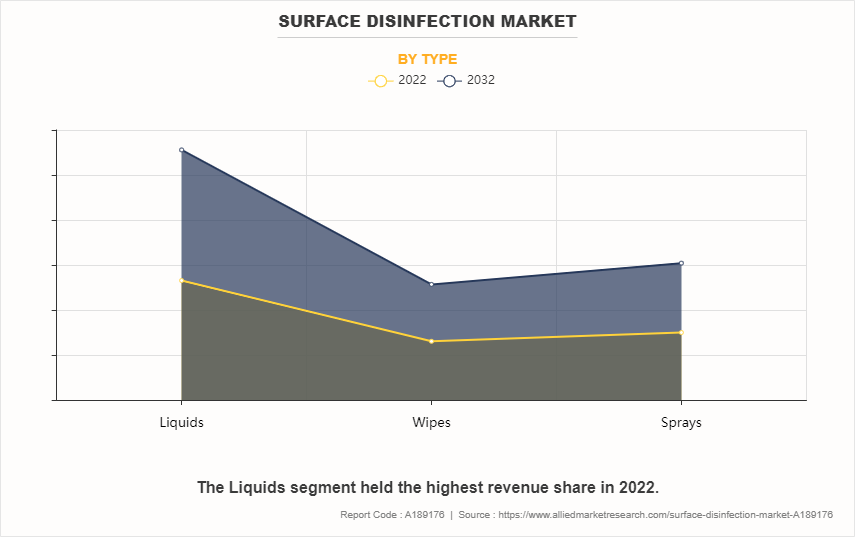
Surface Disinfection Market By Type
The liquids segment accounted for the largest share in 2022 and is expected to register the highest CAGR of 7.7%. This can be attributed to its versatility, ease of application, and compatibility with various disinfection methods. Liquids offer convenience in covering large surface areas efficiently, making them preferred choices across diverse industries such as healthcare, hospitality, and residential sectors.
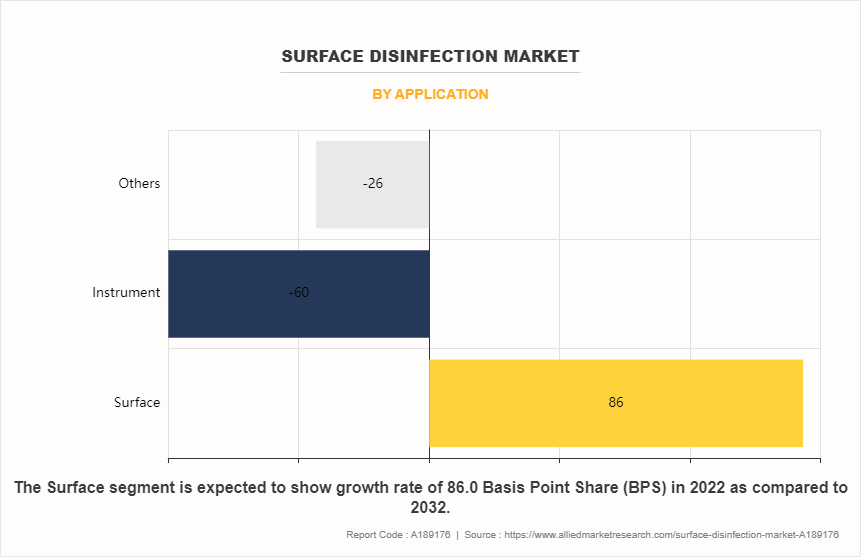
Surface Disinfection Market By Application
The surface segment accounted for the largest share in 2022 and is expected to register the highest CAGR of 7.6%. This can be attributed to the wide array of surfaces requiring disinfection, including countertops, floors, medical equipment, and household items.
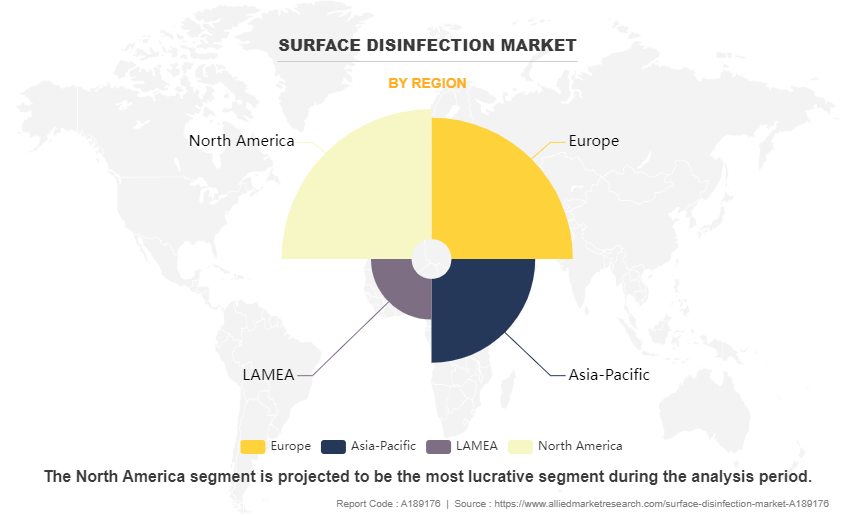
Surface Disinfection Market By Region
North America garnered the largest share in 2022. According to the CMS, a federal government website managed and paid for by the U.S. Centers for Medicare & Medicaid Services, in 2022, the total national health expenditure in the U.S. reached $4.5 trillion, accounting for 17.3% of Gross Domestic Product (GDP). Medicare spending grew to $944.3 billion, representing 21% of total national health expenditure.
Competitive Analysis
The major players operating in the global surface disinfection market are 3M, BASF SE, Ecolab, LANXESS, Lonza, P&G, PAUL HARTMANN AG, PaxChem Ltd., Reckitt Benckiser Group plc., and Spartan Chemical Company, Inc. Other players include Amity International, carenowmedical, CleanWell, LLC., Codi Group, Medline Industries, LP, Nuvik UK Ltd, Parker Laboratories, Inc., STERIS plc, The Clorox Company, and Whiteley.
Some of the developments undertaken by key players are: On May 14, 2021, Ecolab introduced Disinfectant 1 Wipe and Disinfectant 1 Spray. This multifunctional cleaner and disinfectant is intended to be used as part of a broad environmental hygiene and infection prevention program in sensitive healthcare settings. This product launch is expected to stimulate the growth of the surface disinfection market.
On February 24, 2020, P&G introduced Microban 24, a new line of antibacterial household sanitizers that protects surfaces against bacteria for 24 hours. Microban 24 provides a barrier that continues to eliminate bacteria for an entire day, even when the surface is scrubbed or touched repeatedly. This product launch will increase the demand for surface disinfectants, leading to market growth.
Recent Developments in Surface Disinfection Industry
On June 27, 2023, Lysol, a Reckitt Benckiser Group plc. brand, launched its new Lysol Air Sanitizer, the first and only EPA-approved air sanitizing spray that eradicates odors in the air while killing 99.9% of airborne bacteria and viruses. The product reduces the transmission of airborne viruses that cause illnesses, including the common cold, influenza, and coronavirus. This product launch is expected to strengthen the product portfolio of the company, leading to growth of the surface disinfection market.
On April 18, 2023, SC Johnson introduced the new FamilyGuard Brand, a lineup of disinfectant formulas created to help protect families against germs by disinfecting hard, non-porous surfaces. This product launch is expected to increase the demand for surface disinfectants.
On February 8, 2022, SC Johnson Professional launched Quaternary Disinfectant Cleaner in a new easy to measure, squeeze and pour bottle. The packaging of the product makes it easier to measure dilution in a container, automatic scrubber, or spray bottle and cleans, disinfects, and deodorizes in a single cost-effective process. This product is used on surfaces that are washable, hard, non-porous, and do not come in contact with food. These surfaces include floors, garbage cans, worktops, desks, doorknobs, and appliances. This product launch is anticipated to boost market growth during the forecast period.
On November 10, 2020, 3M launched TB Quat Disinfectant Ready-to-Use Cleaner that is approved by the U.S. Environmental Protection Agency (EPA) for kill claims against SARS-CoV-2. This disinfectant, known for its ability to clean, deodorize, and disinfect high-traffic areas such as hospitals, nursing homes, schools, hotels, and office buildings, is offered in a handy spray bottle for consumers to use throughout their entire home. This product launch is expected to boost the growth of the surface disinfection market.
On November 30, 2020, Ecolab introduced Skinman Soft Protect FF, an excellent hand rub with an alcohol base, and Sirafan Speed, a surface disinfectant, both tested successfully against the COVID-19 virus. This product launch is projected to boost market growth during the forecast period.
Public Policies
- Product Registration and Approval: The U.S. Environmental Protection Agency (EPA) has approved more than 500 surface disinfectant products for use against SARS-CoV-2
- Efficacy Standards: According to the International Journal of Environmental Research and Public Health, the guidelines for disinfectant use are primarily on the basis of laboratory data rather than a systematic review of in situ disinfection efficacy. It is critically important for practitioners and researchers to consider system-level efficacy and not just the efficacy of the disinfectant.
Key Benefits For Stakeholders
- This report provides a quantitative analysis of the market segments, current trends, estimations, and dynamics of the surface disinfection market analysis from 2022 to 2032 to identify the prevailing surface disinfection market opportunities.
- The market research is offered along with information related to key drivers, restraints, and opportunities.
- Porter's five forces analysis highlights the potency of buyers and suppliers to enable stakeholders make profit-oriented business decisions and strengthen their supplier-buyer network.
- In-depth analysis of the surface disinfection market segmentation assists to determine the prevailing market opportunities.
- Major countries in each region are mapped according to their revenue contribution to the global market.
- Market player positioning facilitates benchmarking and provides a clear understanding of the present position of the market players.
- The report includes the analysis of the regional as well as global surface disinfection market trends, key players, market segments, application areas, and market growth strategies.
Surface Disinfection Market Report Highlights
| Aspects | Details |
| Market Size By 2032 | USD 5.6 billion |
| Growth Rate | CAGR of 7.4% |
| Forecast period | 2022 - 2032 |
| Report Pages | 250 |
| By Composition |
|
| By Type |
|
| By Application |
|
| By Region |
|
| Key Market Players | paxchem ltd., Ecolab, Spartan Chemical Company, Inc., 3M, Reckitt Benckiser Group plc., P&G, Lonza, Paul Hartmann AG, BASF SE, LANXESS |
Analyst Review
According to the insights of the CXOs of leading companies, the global surface disinfectant market is anticipated to experience substantial growth during the forecast period. This growth is attributed to a rise in the prevalence of hospital-acquired diseases. Furthermore, the increased adoption of surface disinfectants in non-healthcare sectors such as manufacturing, hospitality, and food and beverage is a significant driver for the market expansion.
Despite these positive factors, challenges such as product resistance and overuse of surface disinfectants are restraining market growth. The CXOs further added that the advancements in manufacturing of surface disinfectants offer lucrative opportunities for growth.
The global surface disinfection market was valued at $2.7 billion in 2022, and is projected to reach $5.6 billion by 2032, registering a CAGR of 7.4% from 2023 to 2032.
Healthcare facilities remain the leading application for surface disinfection, driven by stringent infection control standards and the need to prevent healthcare-associated infections (HAIs) in hospitals, clinics, and other medical settings.
Increased demand for sustainable and eco-friendly disinfection solutions, growth in the use of UV-C and other advanced technologies for efficient and rapid surface disinfection, and integration of IoT and AI for smart disinfection management are the upcoming trends of Surface Disinfection Market in the world.
North America is the largest regional market for Surface Disinfection.
The major players operating in the global surface disinfectant market are 3M, BASF SE, Ecolab, LANXESS, Lonza, P&G, PAUL HARTMANN AG, PaxChem Ltd., Reckitt Benckiser Group plc., and Spartan Chemical Company, Inc.
Loading Table Of Content...
Loading Research Methodology...


